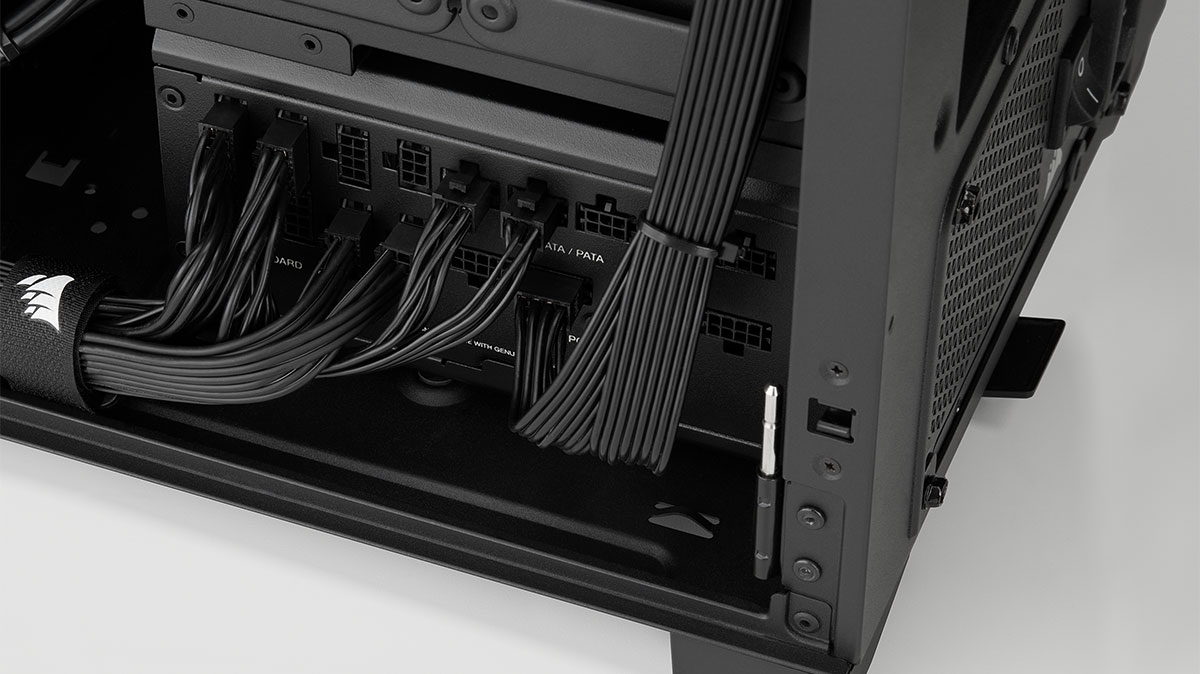
 Image: Adam Patrick Murray / Foundry
Image: Adam Patrick Murray / Foundry
“Oh, it’s easy to build a PC,” says your friend who’s built a dozen before. “It’s like LEGO for grownups!” While it’s true that building your own desktop is probably easier than a lot of people think, getting over the jitters and the less user-friendly parts of your first build is always a bit daunting. But for the first time in a long time, multiple PC hardware vendors are trying to make it easier.
Now to be sure, it is a lot more simple than it used to be. Take storage for example. What used to be awkward at best with a hard drive and an IDE cable became a little simpler with SATA, but you still had two cables going to both the motherboard and the power supply. Now you can just plug in an M.2 drive directly onto the motherboard, making it even simpler than RAM.
A new twist on power supplies
Similar innovations are happening elsewhere. Take Corsair’s latest power supply, for example. On a standard PSU, the inelegant positioning of the cable connections deep inside the case necessitates either cramming your hand deep inside space you can’t easily see, or connecting everything externally — which might not be an option, especially if you’re looking for clean cable routing.

Corsair
Corsair
Corsair
The Corsair RMx Shift solves that problem, rotating the conventional power supply by ninety degrees. Combined with a compact casing for a little extra wiggle room, that makes the power rails easy to reach and route to your necessary components via the rear side of the case (with the underside of the motherboard). Even better, it’ll work in any standard PC case, and it makes shoving all those loose power cables to the backside easy, preserving clean interior airflow.
Keep cables out of sight
Speaking of clean cable routing, Gigabyte is doing its best to make the most annoying part of PC building more or less invisible. We’ve seen case designs that have little raised blockers to make cable routing very nearly invisible, but that doesn’t make it any easier to set up. Project Stealth, in its second revision at this year’s CES, puts all the headers for power connections in the rear of the case.
That means the motherboard, the graphics card, the case’s internal fans, even things like USB motherboard cables are all reversed, pointing to the rear of the case. Not only does that give you a super-clean interior for aesthetics and airflow, it means you can adjust any connections from the rear, without touching the primary chamber at all. Even the CMOS battery for retaining your motherboard’s settings is mounted on the rear! The only downside is that you need to buy the case, motherboard, and GPU all at once in order for it all to work together.
A case that grows with your build
But what if you want a little more flexibility in your case itself? What if you start with a mini-ITX build, but find out later your high-power parts really need a full ATX case? Then you might want to check out the InWin Mod Free, a radical departure for case design that nonetheless accommodates all modern ATX-compliant parts. The case is “skeleton” style, allowing you a huge degree of access to the internal structure because it comes without any kind of siding.
But that’s not where the magic happens. The core case can be bolted onto other skeletal modules — a bigger chamber for a robust power supply, or extra height for a big all-in-one cooler, or a huge addition for a built-in NAS. You can even bolt on a new chamber for an entirely separate computer build, combining multiple machines into one. Both the core case and the add-on modules come in multiple sizes. When you’ve settled on your size and installed your components, you can add in the exterior panels, which come in acrylic, tempered glass, or cooling-friendly mesh on the concept device.
Corsair’s RMx Shift power supply is available now in 750, 850, 1000, and 1200-watt capacities, and Gigabyte’s Project Stealth can be purchased as an all-in-one kit with the case, motherboard, and RTX 3070 GPU. The only downside is that with Gigabyte’s place in the market somewhat uncertain (especially in terms of graphics cards), there’s no guarantee that the line will continue. The InWin Mod Free should hit the market sometime later this year.
All three products are examples of how PC hardware suppliers are trying to make it even easier to build your first PC. Heck, even if you’re building your fiftieth, I doubt anyone will complain about it becoming much easier.
Author: Michael Crider, Staff Writer

Michael is a former graphic designer who’s been building and tweaking desktop computers for longer than he cares to admit. His interests include folk music, football, science fiction, and salsa verde, in no particular order.
Recent stories by Michael Crider:
Corsair’s new One i500 desktop is tiny, pricey, and gorgeousJoin us for The Full Nerd episode 300 today at 3pm Eastern!My best desktop organization gadget is a humble carabiner



